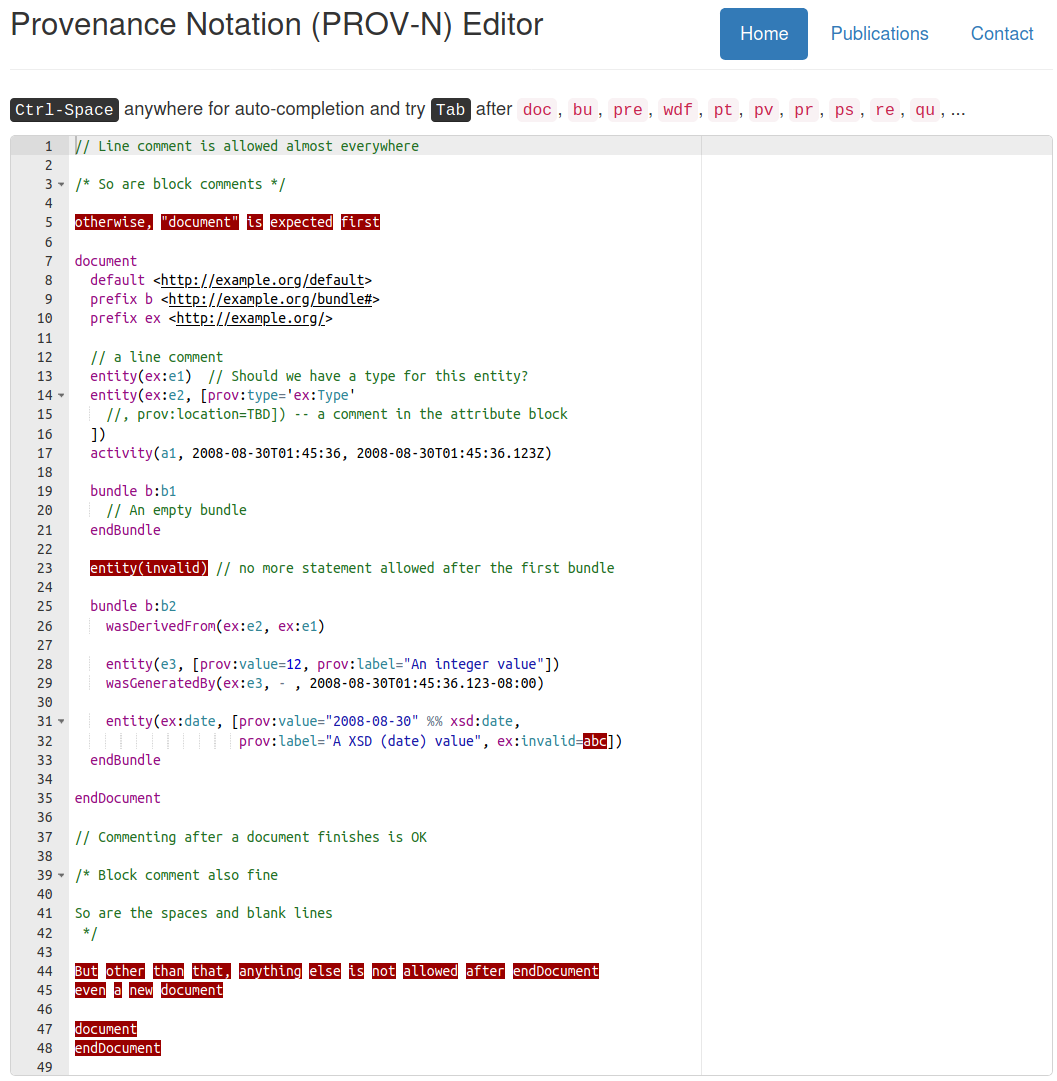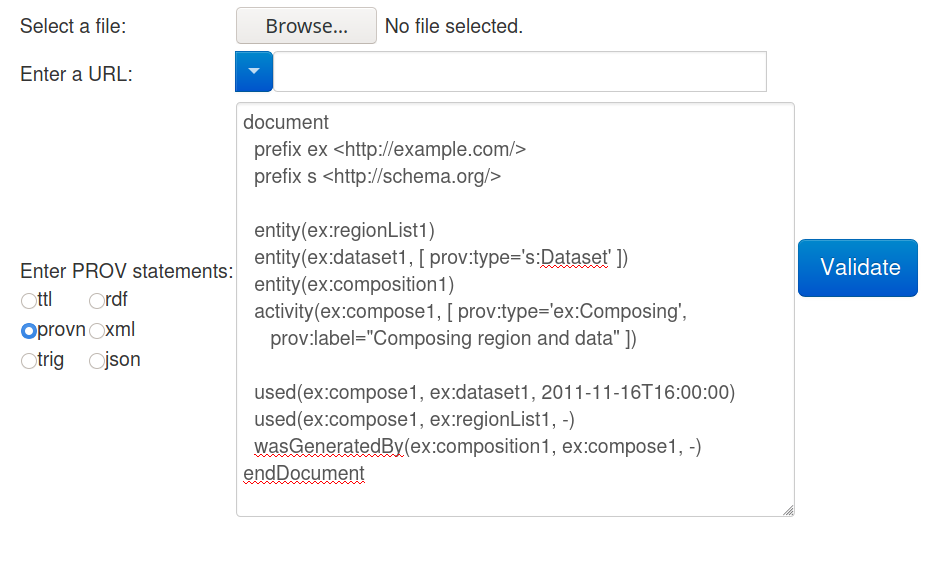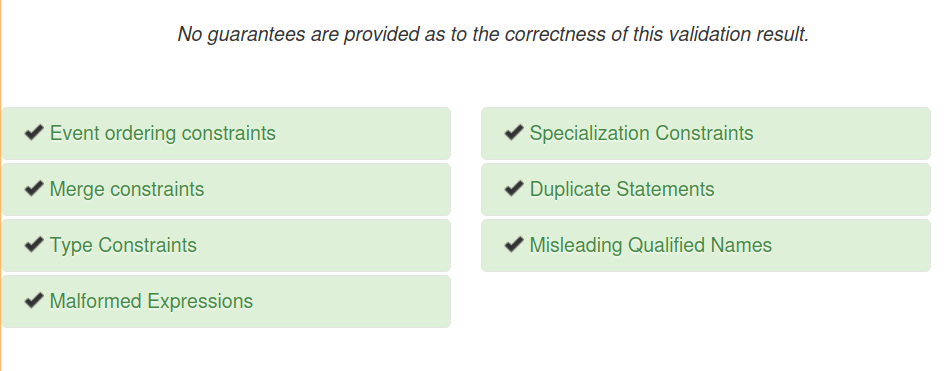Validating and visualising PROV
This blog post gives a gentle PROV-N introdction and then explores tools for validating and visualising PROV.
One of the advantages of W3C PROV having a common data model is that it can be serialized, or written out, in multiple file formats. The PROV family of W3C specifications describe mappings PROV-XML and PROV-O (which, being based on OWL2 itself has multiple serializations, for Linked Data including RDF formats Turtle and JSON-LD.
In addition to these standard approaches we also have PROV-JSON and PROV-JSONLD which could be well-suited for Web applications. All of these can in theory be mapped to each-other through the common PROV Data Model and the use of URIs as Linked Data global identifiers.
PROV-N
PROV also specifies its own language, PROV-N, a text-based file format that most closely represent the PROV Data Model. This representation is used by the PROV Primer to explain the PROV types (entity/agent/activity) and their relationships (e.g. wasAttributedTo). For example:
document
prefix ex <http://example.com/>
prefix s <http://schema.org/>
entity(ex:regionList)
entity(ex:dataset, [ prov:type='s:Dataset' ])
entity(ex:composition)
activity(ex:composing, [ prov:type='ex:Composing',
prov:label="Composing region and data" ])
agent(ex:derek,
[ prov:type='prov:Person', s:givenName="Derek",
s:email="derek@example.org" ])
used(ex:composing, ex:dataset, 2011-11-16T16:00:00)
used(ex:composing, ex:regionList, -)
wasGeneratedBy(ex:composition, ex:composing,
2011-11-16T16:45:00)
wasAssociatedWith(ex:composing, ex:derek, -)
wasAttributedTo(ex:composition, ex:derek)
endDocument
Tip: See the PROV-N cheat sheet for an overview of all PROV-N relations and their arguments.
The above PROV-N can be rendered as a diagram:
Let’s go through the PROV-N line by line:
prefixmapsexto the URI namespace starting withhttp://example.com/- PROV identifiers like
ex:dataset1can be expanded to a Linked Data global identifierhttp://example.com/dataset1(which in an ideal world would describe or perhaps let you download the dataset) - External vocabularies like schema.org can be reused, e.g. the property
s:givenNameexpands with the prefixs:to form the URI http://schema.org/givenName prefix prov <http://www.w3.org/ns/prov#>is implicit, and is the internal namespace for PROV types and attributes.- Tip: It is possible to declare
default <http://example.com/>after whichex:regionListcan be shortened toregionList, however it is recommended to always use explicit prefixes to ease reuse and combination of PROV-N files.
- PROV identifiers like
entity(ex:regionList)declares the existence of an entity with that identifier. It can thereafter be used in relationships expecting an entity.- The entity
ex:datasetis similarly declared, but also assigning a more specific type, usinghttp://schema.org/Datasetfrom the external vocabulary. - The activity
ex:compositionis typed using an ad-hoc typeex:Composingfrom our own namespace, but also adds a string attribute to give a more descriptive label. - The agent identified as
ex:derekis described with attributes from schema.org/Person- Agents can alternatively have type
prov:Organization(best described using schema.org/Organization) orprov:SoftwareAgent(described using schema.org/SoftwareApplication or schema.org/SoftwareSourceCode)
- Agents can alternatively have type
- Relationships like
usedgoes backwards in time- The activity
ex:composingused the pre-exsting entityex:dataset. - The usage happened on 16 Nov 2011 at 16:00 (given in ISO8601 date-time format)
- The activity
- The second
use, this time ofex:regionList, has a placeholder-indicating that the required PROV-N argument for date-time is unknown. - The relationship
wasGeneratedByalso points backwards in time, the new entityex:compositionwas generated by the activityex:composingsome time later, at 16:45. wasAssociatedWithindicates that our agent Derek took part in theex:composingactivity, with placeholder – as we don’t know when.wasAttributedTosays Derek was (at least partially) invovled in generating the composition.
Some subtleties about PROV-N worth mentioning:
-
Like other Linked Data representations, PROV has an open world assumption, meaning that statements given may be a partial description of the actual provenance.
- Additional statements carrying new knowledge can always be added, as long as they don’t break semantic constraints.
-
Statements can be listed in any order
- It is convention to use a chronological partial order old…new so that the last lines in PROV represent the newest events.
-
Entities, Agents and Activities should be explicitly declared as such.
-
By convention declarations can be grouped together towards the top (as in above example)
-
Alternatively, a declaration can be listed just before the first reference to its identifier in other statements.
-
If a relationship is not showing up in PROV visualization, ensure it has the correct declaration.
-
-
Identifiers are globally unique according to the prefix mapping to URI namespaces.
- Use of
http://example.com/namespaces is legal for examples/prototypes/training, but is at danger of collision if PROV graphs are combined. - To encourage Linked Data, as a minimum use a namespace leading to a human readable page, appending
# - For instance PROV entities described within this blog post could use:
prefix vv <https://s11.no/2020/prov/validating-and-visualising-prov/#>
- Use of
-
An entity can’t concurrently be an activity.
- However an agent could concurrently be an entity or an activity
Two immediate questions arise when faced with this “new” syntax and language for provenance:
- How can we validate its syntax and the correct use of PROV types and arguments to PROV relations?
- How can we convert from/to PROV-N and file formats that are more accessible programmatically, such as PROV-JSONLD or PROV-O in Turtle?
PROV tooling
KCL’s openprovenance.org lists PROV supporting tools and libraries, including: ProvToolbox (Java), Prov Python, ProvJS. These libraries can be used by developers for generating or consuming PROV from within a programmatic environment like Jupyter Notebook or a data management application.
In addition there are graphical tools for PROV editing, validation, conversion and visualization described below:
PROV-N editor
The PROV-N Editor is an online text editor that provides syntax highlighting and autocomplete for PROV-N, and is useful for beginners new to PROV-N.

Screenshot of https://openprovenance.org/tools/editor/ as of 2020-11-13
Note that the starting example PROV-N aims to be somewhat complete, including the advanced use of nested bundle .…. endBundle block, //comments and deliberate invalid statements (shown in red).
We recommend using the PROV-N Editor starting with a simpler example, and to use copy-paste to save the PROV-N locally to a file, using a text editor like Visual Studio Code (which unfortunately do not have syntax highlighting for PROV-N):
PROV-N example from above edited in VSCodium
Note: The file extension for PROVN is .provn, but you may use .provn.txt to ensure it opens in a text editor. Do not edit PROV-N in a text processor like Microsoft Word, as its binary format .docx (actually a structured ZIP archive of XML files) is not parseable by PROV tools; in addition text processors may provide unhelpful assistance such as changing "quotes" to “curly quotes” which are not part of PROV-N syntax.
Validating PROV
Although the PROV-N editor does syntax highlighting and can detect glaring mistakes such as invalid file comments, it does not do deeper inspection to detect mistakes such as missing commas, mismatches parentheses, wrong or missing argument to PROV relations. You may also accidentally have added logically inconsistent statements, such as:
document
prefix ex <http://example.com/back-to-the-future/>
entity(ex:results)
entity(ex:data)
entity(ex:interviews)
wasDerivedFrom(ex:results, ex:data)
wasDerivedFrom(ex:data, ex:interviews)
wasDerivedFrom(ex:interviews, ex:results)
endDocument
While the above “scruffy” PROV-N file is syntactically valid, and each of the statements are OK semantically, as a whole we seem to have added a semantic violation of causality; an entity can’t be generated from entities not yet existing. An attempt to draw the above as a diagram will show an endless loop of derivations:
To ensure your PROV-N is both syntactically valid and semantically consistent, it is best to use a PROV validator.
PROV Validator
The openprovenance.org PROV validator can support PROV-N; remember to tick the correct syntax, specially when pasting rather than uploading a file with the correct extension.


The checks performed by the PROV Validator mainly focus on semantic constraints such as correct typing and ensuring provenance goes backwards in time without any causality loops (e.g. you can’t be your own grandparent).
Unfortunately we have found that the PROV Validator service occasionally does not detect syntactic PROV-N errors. For instance if we delete the placeholder argument ,- from the wasGeneratedBy statement above, that bug is silently accepted by this validator, even though the timestamp is required by PROV-N definition of used. If there are syntactic errors the user is not provided with line-numbers of where the error might be.
Therefore we also recommend using the PROV Toolbox command line tool to validate the PROV-N syntax before using the PROV Validator.
PROV Toolbox
The PROV Toolbox is a Java library for consuming and generating PROV, but it also includes a versatile command line tool that can do:
- Validation
- Conversion
- Merging
- Visualization
- Generate PROV from templates
See PROV Toolbox tutorials for further information.
Installing PROV Toolbox
To use the command line tool, the PROV Toolbox must be installed locally on a desktop/laptop computer.
Installation requirements lists what is needed for compiling and development. For the command line tool we’ve found it is sufficient to have:
- Java JDK 9 or later (tested with OpenJDK 11)
- graphviz command
dot(only needed for generating diagrams)
Binary packages of PROV Toolbox are included for Linux (RedHat/Centos, Debian/Ubuntu), although they are not always updated.
Note: Installing Java and PROV Toolbox in Windows users requires a series of steps that are detailed separately.
See also PROV Toolbox in MacOS for Mac users.
After installing or unzipping to a subdirectory you should be able to run its provconvert or bin/provconvert command:
(base) stain@biggie:~/software/ProvToolbox$ bin/provconvert -help
usage: provconvert [-allexpanded] [-bindformat <string>] [-bindings
<file>] [-bindver <int>] [-builder] [-compare <file>] [-config]
[-debug] [-flatten] [-formats] [-generator <string>] [-genorder]
[-help] [-index] [-infile <file>] [-informat <string>] [-layout
<string>] [-location <location>] [-log2prov <file>] [-merge <file>]
[-namespaces <file>] [-outcompare <file>] [-outfile <file>]
[-outformat <string>] [-package <package>] [-template <string>]
[-templatebuilder <file>] [-title <string>] [-verbose] [-version]
-allexpanded,--allexpanded In template expansion,
generate term if all
variables are bound.
-bindformat,--bindformat <string> specify the format of the
bindings
-bindings,--bindings <file> use given file as bindings
for template expansion
(template is provided as
infile)
-bindver,--bindver <int> bindings version
-builder,--builder template builder
-compare,--compare <file> compare with given file
-config,--config get configuration
-debug,--debug print debugging information
-flatten,--flatten flatten all bundles in a
single document (to used with
-index option or -merge
option)
-formats,--formats list supported formats
-generator,--generator <string> graph generator
N:n:first:seed:e1
-genorder,--genorder In template expansion,
generate order attribute. By
default does not.
-help,--help print this message
-index,--index index all elements and edges
of a document, merging them
where appropriate
-infile,--infile <file> use given file as input
-informat,--informat <string> specify the format of the
input
-layout,--layout <string> dot layout: circo, dot
(default), fdp, neato, osage,
sfdp, twopi
-location,--location <location> location of where the
template resource is to be
found at runtime
-log2prov,--log2prov <file> fully qualified ClassName of
initialiser in jar file
-merge,--merge <file> merge all documents (listed
in file argument) into a
single document
-namespaces,--namespaces <file> use given file as declaration
of prefix namespaces
-outcompare,--outcompare <file> output file for log of
comparison
-outfile,--outfile <file> use given file as output
-outformat,--outformat <string> specify the format of the
output
-package,--package <package> package in which bindings
bean class is generated
-template,--template <string> template name, used to create
bindings bean class name
-templatebuilder,--templatebuilder <file> template builder
configuration
-title,--title <string> document title
-verbose,--verbose be verbose
-version,--version print the version information
and exit
Here is an example of converting from provn to RDF Turtle.
(base) stain@biggie:~/software/ProvToolbox$ bin/provconvert -infile test.provn -outfile test.ttl
The example output is valid RDF and uses the same prefixes in a different notation. (This kind of output can be loaded in Triple stores like Jena Fuseki for further queries).
Note that as a UNIX-like tool, no output from provconvert means the conversion was successful. We can use provconvert for validation, even if we do not need the translated file. If the provn has syntax errors, this will be reported as:
(base) stain@biggie:~/software/ProvToolbox$ bin/provconvert -infile test.provn -outfile test.ttl
13:46:42,100 WARN Utility:35 - test.provn line 12:34 mismatched input ')' expecting ','
This tells us that in line 12, position 34, PROV-N expected an additional argument (the - placeholder) instead of the closing character ).
If you have installed Graphviz dot you can also make SVG or PNG images:
bin/provconvert -infile test.provn -outfile test.svg

Note that on Windows you would need to modify the PATH system variable for GraphViz to work, see installing PROV Toolbox for Windows.
PROV Store
PROV Store allows uploading of PROV documents, conversion and visualization. It is recommended to edit and validate PROV-N files with the methods listed above before uploading, as the PROV Store can be more picky on compliance with the PROV standards.
There seems to be a bug in email notifications not being sent when registering, so use the big “Register for free account” on https://openprovenance.org/store/account/signup/ which lets you straight in.
Hack: For a second registration if email link has not been received, make a username like fred14 and add +14 to your email address: fred+14@example.org
Comments
Thank you for writing up detailed guidance on the provenance tools. Are you still seeing the email problem when signing up for an account on our server? I’m trying to determine if this issue a temporary glitch or something more persistent that requires attention. BTW, if you want to PROV-N syntax highlighting in Textmate or Sublime Text, there is a grammar file available. See this post for more information: https://trungdong.github.io/prov-n-textmate.html. It was done a while ago but I hope it still works (I’ve been using the same grammar file with Sublime Text since then).
